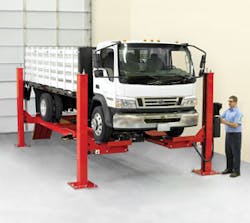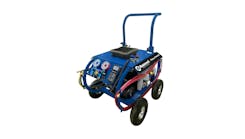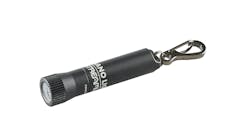Whether lifts are your main game or simply a capital equipment sideline to your hardline life, making a successful sale consists of being observant and keeping an open conversation going.
Lifts are an essential part of every shop. A lift that’s down for maintenance, broken, or even just cumbersome to use will reflect poorly on its salesman. Likewise, a lift that is unused because it doesn’t lift enough of the vehicles that come into the shop will not go over well.
Any of these examples will hurt your ability to continue selling in a shop, whether you’re asking for more lift sales or trying to move a wrench set or tool cart.
So, where should a successful lift sale start? It starts with a close look at the shop on two different levels.
EVALUATING THE SHOP, VEHICLES
“The distributor should do a fleet evaluation with the shop owner considering a lift, as much as a site evaluation,” said Steve Perlstein, Mohawk Lifts.
The fleet evaluation is to recommend a lift that covers everything that comes into the shop, from the smallest car to the largest vehicle the shop services, Perlstein said.
“Not 90 percent, not 80 percent, not 95 percent. … If you work on 100 percent of the vehicles, the lift you buy should be able to raise 100 percent of the vehicles,” Perlstein said.
If you tell the owner the lift covers everything, you’d better be sure it covers down to SmartCars, Perlstein said. This also happens to be about the best ROI available, when one lift services everything coming in, he said.
Once the fleet evaluation is complete, the site evaluation is necessary to check ceiling height for clearance, thickness of the floor to hold a lift, check for proper electricity, etc., Perlstein said.
Any safety issues with the shop’s current lifts should also be key, said Pete Liebetreu, Hunter Engineering Co. product manager for lift and racks.
“If a lift has any safety issues, then they either need to be corrected or if that is not possible then the lift should be replaced. Lifts are generally very safe, but have perhaps the greatest potential to harm and operator of any shop equipment if not in safe operating order,” Liebetreu said.
He echoed Perlstein’s need to evaluate a shop’s fleet of customers. It is also a safety concern, he said, since “lifts that are not sized properly encourage unsafe work-arounds.”
SAFETY FIRST
“As vehicles have gotten heavier, lift capacities have increased to make it possible to safely raise these cars and trucks,” explained David Fischmer, Rotary Lift marketing communications manager. “If a shop still has old 7,000-lbs. capacity lifts, but its workload now includes a lot of trucks, SUVs and vans, the shop may need to upgrade to new, higher-capacity lifts.
“Similarly, older runway-style lifts were designed to accommodate wheelbases of no more than 158 inches. Shops equipped with these lifts won’t be able to properly pick up many of today’s longer trucks. These lifts should be replaced with new models that can handle the longer wheelbases.”
Other outdated items to look for include older in-ground lifts that have started leaking, Fischmer said. “If a shop is adding a lot of hydraulic fluid to an old-fashioned in-ground lift, chances are good that it has developed a leak.
“These lifts can be replaced with modern, environmentally friendly in-ground lifts in which the lift is installed inside a cassette that protects the lift from the environment and the environment from the lift,” he said.
Fischmer said distributors should also keep up on the lift certifications of their customers.
“If the lift doesn’t have a gold ‘ALI Certified/Validated by ETL’ label, it may not be certified. Only lifts that have passed independent, third-party testing to validate that they meet ANSI/ALI ALCTV-2006 safety standards can use this label,” he said. “If the lift is not certified, the shop has no guarantee that it meets accepted industry safety standards.”
KNOW YOUR STUFF …AND THEIR STUFF
You’ve evaluated the vehicles coming in. You’ve evaluated the physical environment the lift would be installed in. What more do you need to do?
“A distributor must know the equipment he’s selling inside and out, backwards and forwards … to be able to answer a shop owner’s objections when he wants to discuss brands x, y and z,” Perlstein said.
This applies to any piece of equipment you sell, not just lifts.
Perlstein said it is imperative to know your competition’s equipment as well as you know what you’re selling.
“Get your hands on it. Kick the tires and learn about the stuff you’re selling,” Perlstein said.
You also can rely on the company’s experts for truly unique questions. Don’t be afraid of making a quick phone call to settle a customer’s inquiry when you don’t have an answer right at hand.
Current trends are an increasing number of specialty lifts for specific jobs and maintenance.
“The distributor should have a thorough understanding of the shop owner’s current business and plans for the future, including the types of vehicles serviced and services performed,” Fischmer said.
“Alignment lifts … have many new productivity features that can really save time and add quality to the process,” Liebetreu added.
“Lifts are increasingly specialized, particularly in the alignment category. It pays to really understand your product in these categories.”


